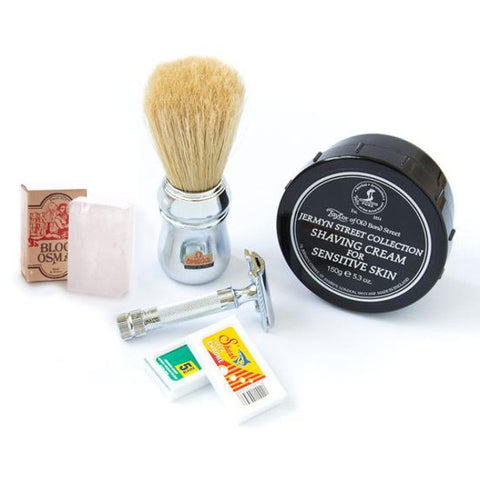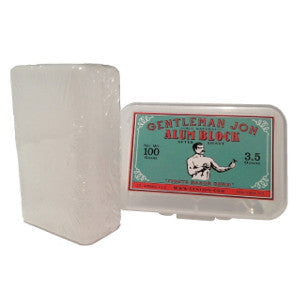6 Wet Shaving Tips for Beginners

If you are a beginner wet shaver or considering wet shaving with a safety razor, then there are a few tips you should know before you dive into your first shave. You are probably making the switch to a safety razor because you want to experience a better shave, but to achieve this it’s important to understand shaving technique in order to get a closer, more comfortable shave. In this post we’ve outlined our top six wet shaving tips for beginners and aspiring wet shavers so that you can get the most out of your new wet shaving kit and safety razor.
1. Prepare Your Face
Before you pick up your safety razor, your face needs a little preparation to reduce irritation. As a beginner, the best way to do this is to start off with a hot shower and begin your shave immediately after. The hot water will help to soften and raise the hairs on your face, making them easier to shave.
Additionally, wash your face with a proper face soap to remove any acne or razor burn causing bacteria. Avoid using body or hand soaps as they can remove too much of the natural oils meant to protect and moisturize your skin. Even a proper, nick free shave can cause your pores to be susceptible to these types of bacteria, so you’ll want to get rid of them before you even start.
2. Perfect Your Lather
Creating the perfect lather is going to take time and experience to master, but is the best way to protect your skin while wet shaving. This is because shaving lather is meant to add a lubricating barrier between your skin and the razor blade as it moves across your skin. Avoid using canned shaving creams, as these are often under performing and less lubricating, and instead use a proper shaving cream or soap instead. We recommend creating lather using a traditional shaving brush in your hand or directly on your face to really get a feel for the lather as you create it.
Start by loading your brush with soap or cream and slowly adding more water to the mixture as you create the lather. If your lather is thick, sticky, or paste like, then more water is needed. If your lather is runny or contains bubbles, then you’ve added too much water. Experience will give you a sense of how much water is too little or too much.
3. Shave With the Grain
As a beginner, it’s important to begin shaving in the same direction that your hair grows from your skin to avoid irritation. Sure, you might get a closer shave, but shaving against or even across the grain of your facial hair could cause increased irritation and severe razor burn. We recommend you slowly progress to these additional shaving passes as you improve your technique and better understand how your face will react.
To understand how your facial hair grows, allow your hair to grow for a few days so that you can easily see in which direction hairs are growing from your face. It’s recommended that you use this diagram to draw arrows on how your hair grows on separate sections of your face. To shave with the grain of your hair, you will want to move the safety razor or blade from the base of the hair at the pore to the end of the hair. Often this will be in a downward angle on your cheeks, but could be very different on your neck or other parts of the face depending on how your hair uniquely grows. For more information on these techniques, visit our post Shaving Against the Grain: How to Map Your Facial Hair.
4. Don’t Apply Pressure
This might be the biggest change from how you should use a safety razor over the cartridge razor you’ve been previously using. When using a safety razor, you’ll want to use minimal or no pressure at all when moving the razor across your face. The weight of the razor itself should create enough pressure to shave the hairs as it’s moved along your face. Adding additional pressure will interfere with the lather’s ability to protect your skin and ultimately create additional irritation. Rather than apply pressure to get a closer shave, wet shaving is all about using multiple pass to slowly reduce the length of stubble. Just remember to rinse your face and re-lather between passes.
5. Slow Down
Wet shaving with a safety razor should take longer than your previous shave with a cartridge razor. As a result, you should achieve a closer, more comfortable shave and even begin to enjoy the process. If you don’t have the time this morning, grab your old cartridge or electric razor but do not rush a shave with your safety razor. You’ll likely do more harm than good!
Use short, steady strokes and remember to minimize pressure. Focus on trying to achieve the ideal blade angle of around thirty degrees for the closest cut. Listen to the sound of the blade cutting your hair to help achieve proper pressure and angle. Practice creating a slick, hydrated lather. Enjoy the scents and experience. It may take more time, but all of this will become easier with practice.
6. Try Different Blades
It’s important to experience different razor blades as you are getting started. Every shaver will have their own favorite blade that they will point you toward, but ultimately you’ll have to make your own choice. Blade preference can depend on a lot of things that are unique to the individual including hair thickness, skin sensitivity, the razor you are using, price and more. Grab yourself a razor blade sampler and play around with the different blades to find which performs the best for you.
We hope these wet shaving tips will help you have a better introduction to wet shaving with a safety razor. Remember to practice these techniques and take it slow! If these wet shaving tips helped you improve your wet shaving experience, share with your friends and leave us a comment below! If you are interested in enjoying a traditional wet shave of your own and don’t yet have a safety razor, head over to our store to shop the wet shaving kits we have to offer.
Photo Credit: outcast104





